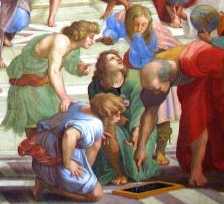Using a 2300 year old textbook
Today I am starting to look at the results of the first test I give each year on Euclid's Book I in Honors Geometry, covering Theorems 1-29. I am always surprised at how foreign the worldview of Euclid is to the average teenager. When I first encounted Euclid, I found a world that made sense, a world where someone had taken care of most of the details, a world where someone remembered what he had JUST SAID and didn't have to repeat himself. I made myself at home and tried to make my teaching like his.
When students find Euclid confusing I have to remind myself that to them, looking at things logically may look like just one more "alternative lifestyle," albeit one that most of them would prefer to leave unexplored and unpondered. When I push them headlong over the "Asses Bridge" (Thm 5, or the Isoceles triangle theorem, the first one proven using congruent triangles) most of them have only a vague idea where the road will lead them. By the time we get to theorem 24 or 25, I have kids start to say "I'm getting this!" in a cautiously optimistic way.
It is awesome to use a textbook that has rarely been out of use somewhere in the world for the last 2300 years. Apparently preserved by Muslims during the middle ages, it was the staple of architect, lawyer, doctor and carpenter alike throughout history, teaching them not only the properties of parallelograms but how to reason clearly and how to argue a case and how to solve problems no one had ever thought of.
I always tell kids we have the Muslims to thank for preserving the text of Euclid and even for adding valuable commentary. But I also make sure to tell them that Muslim contributions to science pretty much ended before the European Rennaisance. And though the Muslims preserved the ancient Greek and Latin classics, the development of modern scientific thinking was not intitiated or brought to fruition by Muslims, but by Christians and Jews generally. So much for the false dichotomy between religion and science. But all alike were inspired by the work of the Master Euclid.
When students find Euclid confusing I have to remind myself that to them, looking at things logically may look like just one more "alternative lifestyle," albeit one that most of them would prefer to leave unexplored and unpondered. When I push them headlong over the "Asses Bridge" (Thm 5, or the Isoceles triangle theorem, the first one proven using congruent triangles) most of them have only a vague idea where the road will lead them. By the time we get to theorem 24 or 25, I have kids start to say "I'm getting this!" in a cautiously optimistic way.
It is awesome to use a textbook that has rarely been out of use somewhere in the world for the last 2300 years. Apparently preserved by Muslims during the middle ages, it was the staple of architect, lawyer, doctor and carpenter alike throughout history, teaching them not only the properties of parallelograms but how to reason clearly and how to argue a case and how to solve problems no one had ever thought of.
I always tell kids we have the Muslims to thank for preserving the text of Euclid and even for adding valuable commentary. But I also make sure to tell them that Muslim contributions to science pretty much ended before the European Rennaisance. And though the Muslims preserved the ancient Greek and Latin classics, the development of modern scientific thinking was not intitiated or brought to fruition by Muslims, but by Christians and Jews generally. So much for the false dichotomy between religion and science. But all alike were inspired by the work of the Master Euclid.


1 Comments:
Welcome to the blogworld. I found you via a post at Recovering Dissident.
Geometry...God bless you for teaching it, and please, have mercy on those students who have trouble grasping the concepts.
Actually, I did very well with "concepts", I just couldn't grasp the mathematical reality of it. Thus, in 10th Grade, I geometrically proved that God does indeed exist...I passed, then never looked back.
Some of this comes more easily to some of you...some of us just don't have the gift. But I do think that if students were truly exposed to the world views of Euclid and other philosophers, they would have a much better and more coherent understanding of the world today.
Sadly, education is very much out of step with historical reality, and we all suffer for it.
Post a Comment
<< Home